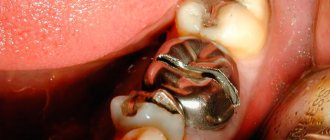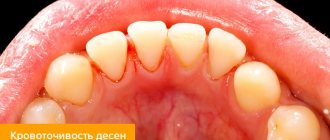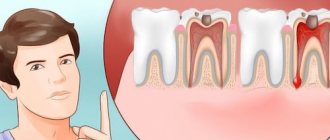Sinusitis
Appears due to constant inflammation in the oral cavity. The risk is higher if the upper molars and premolars (these are closest to the maxillary sinuses) are affected. The infection penetrates the maxillary sinuses and affects them, causing severe headaches, high fever, and constant purulent mucous discharge from the nasopharynx. Without adequate treatment, sinusitis becomes chronic and can provoke meningitis, sepsis localized near the brain, and damage to nerve endings. It cannot be treated only by relieving symptoms: antibacterial therapy and endodontic treatment are needed.
How not to die from a bad tooth
Cellulitis is a diffuse purulent inflammation, which, in the absence of adequate treatment, leads to death. Quite often, the cause of the formation of phlegmon is a diseased tooth. Igor Panin, head of the department, told the Sibmeda portal how to avoid becoming a victim of a deadly disease. Department of Maxillofacial Surgery of the Novosibirsk Regional Hospital.
– Igor Anatolyevich, is phlegmon a common disease?
– Phlegmons of various localizations, including those of odontogenic etiology, that is, from teeth, are quite common. Patients with phlegmon make up a significant part of the patients in our department.
- What is the reason?
– Despite the rapid development of dentistry, patients with a healthy oral cavity are not as common as we would like.
Diseased teeth are, most often, the cause of the development of severe phlegmons of the face and neck, which regularly lead to death in this group of patients - due to neglect and the development of associated complications.
Such complications include the development of chest inflammation, various types of breathing problems, sepsis, as well as some other conditions that can lead to the death of the patient.
It happens that the development of phlegmon is associated with the removal of teeth, and with the fact that the inflammatory process from the tooth, despite its removal, spreads to the surrounding tissues.
In most cases, the reason for the development of phlegmon is the lack of visits to dentists and late treatment when complications develop.
– Can phlegmon develop from pulpitis?
– It is incorrect to say that phlegmon develops as a result of pulpitis. This is not typical for pulpitis. Still, phlegmon often develops when the pulp is no longer present, and when there is an inflammatory process in the area of the roots of the teeth.
– Does the development of phlegmon often end in death for the patient?
– Unfortunately, every year people die from phlegmon of odontogenic etymology in the Novosibirsk region. I won’t say that such cases are registered every month, but every year.
Fortunately, most patients can still be cured if treated in a timely manner.
But if we talk about advanced cases, when the patient needs to be treated for complications that have already developed, then we have such patients all the time. As a rule, they are in the intensive care unit. Their recovery is a long process; the state has to invest large sums of money for such patients. The process of treating a patient with severe phlegmon can take more than a month.
– It turns out that such dangerous consequences arise simply because of a tooth that is not treated in time?
- More often. There are, of course, other causes of phlegmon - consequences of injuries, various inflammatory diseases of the tonsils, but the most serious problem is precisely those phlegmons that develop as a result of dental disease.
Cellulitis that develops from tonsils or injuries is still of a milder nature than phlegmon from teeth.
The largest group of patients are patients who sought medical help late. When a person has a toothache, he self-medicates: he rinses with soda, takes pills, but the tooth continues to ache, and the inflammatory process extends beyond the boundaries of this tooth into the surrounding tissues, with the development of severe complications.
Less often, situations arise when a patient consults a doctor to remove a diseased tooth or treat it, but despite the fact that the doctor carries out therapeutic measures, the inflammatory process progresses and the patient, as a rule, comes to us.
– How quickly does phlegmon form? This is not an instant process, is it?
– In fact, the microflora in teeth is aggressive, and the development of phlegmon can occur within hours. The speed of development depends on the general condition of the body, age, use of antibiotics and some other factors that can stop this process. But these processes are very serious, and the development of complications cannot always be predicted.
Therefore, if there is a suspicion of phlegmon of the oral cavity and neck, first of all, an urgent visit to the hospital is necessary, where a decision on further treatment tactics will be made.
– By what symptoms can one suspect phlegmon?
– As a rule, the process begins with swelling on the face or neck. The mouth may have difficulty opening, and there may be pain when swallowing. The development of phlegmon is always accompanied by fever, weakness, and sweating.
The presence of swelling on the face and high temperature is a reason to contact a dental surgeon at the clinic as quickly as possible.
In our city, you can get dental care around the clock. And the clinic doctor, even if he cannot provide assistance himself, will assess the patient’s condition and refer him to the hospital if necessary.
– How long does it take for a patient to seek medical help?
– Let’s just say that time in this case does not work for the patient. The faster the better. With timely treatment, you can get by with a smaller amount of surgical intervention. When the situation has not reached the point of phlegmon, and the inflammation is localized in the area of the tooth, it does not spread to the surrounding tissues.
Still, more often it happens like this: the tooth was removed, antibiotics were prescribed, if necessary, and the purulent process stopped there. Most of these patients are treated on an outpatient basis.
But in this group there are patients when the inflammation spreads to neighboring areas, and then the person must be hospitalized in a hospital.
– Is it possible to confuse phlegmon with another acute disease?
– There is confusion with some diseases that are also accompanied by swelling in the neck. If in doubt, it is important to contact the appropriate specialist - a dental surgeon at the clinic, first of all. He will make a decision and, if necessary, send you to the hospital.
– Which medical institutions in Novosibirsk provide assistance to such patients?
– In our city, inpatient care for patients with phlegmon is provided in three hospitals. For the adult urban population - in the department of maxillofacial surgery of the 34th hospital, for the regional population - in the Novosibirsk Regional Hospital and for the children's population - in the 3rd emergency hospital.
– How is the diagnosis of “phlegmon” made or specified?
– As a rule, the diagnosis is made primarily on the basis of clinical data. This does not require any special examination. Tomography can be performed to clarify which areas are affected by phlegmon in a given patient.
– What treatment methods are used for phlegmon?
– The only possible method of treating patients with phlegmon is surgery: wide incisions are required to eliminate the purulent process. No other has been invented yet. No pills or injections will help without surgery.
It is important to know: patients with phlegmon are not treated with antibiotics. Antibiotics are used after surgical treatment, and not instead.
Everything must be combined - surgery, antibiotics, infusion therapy, and many other procedures.
– Igor Anatolyevich, how can you protect yourself from such a dangerous disease as phlegmon?
– It is important to remember that the presence of rotten teeth in the mouth is a time bomb that can explode at any time. There is, of course, an element of luck, but I don’t recommend relying on it in this matter.
Therefore, the main preventive measure is, of course, regular visits to the dentist in order to treat carious teeth, sanitize foci of chronic odontogenic infection, so as not to lead to the development of phlegmon. After all, the strategic task is not to consult a doctor at the right time, when phlegmon has already developed, and not to allow its development, in principle.
Subscribe to our Instagram and Facebook to keep abreast of exciting events and news from the world of medicine, health and beauty.
TMJ dysfunction
Caries and subsequent pulpitis lead to tooth loss, occlusal disorders, problems with chewing, etc. This changes the load on the temporomandibular joint, causing dysfunction. When the TMJ “does not work” correctly, headaches, neck pain, bruxism, ringing and noise in the ears, and disturbances in the movements of the lower jaw may appear. If the dysfunction persists for a long time and worsens, eating disorders may develop against its background (the patient is afraid to eat solid, chewing foods because of pain), sleep disorders, depression, and other disorders.
You have questions?
We will call you back within 30 seconds
+7
Diseases of the gastrointestinal tract
Pathogenic microbes from the oral cavity easily migrate with food into the gastrointestinal tract. When they enter the digestive organs, they cause irritation of the mucous membrane. At best, this leads to digestive disorders, for example, bloating, heartburn, and bowel dysfunction.
But if the number and growth of pathogenic microorganisms rapidly increases, then very soon a person feels the first symptoms of gastritis, stomach ulcers or colitis.
In addition, diseased teeth are not able to cope with their main task. The process of chewing food is disrupted, the load on the digestive organs increases, which also negatively affects the functioning of the gastrointestinal tract.
The cardiovascular system
Against the background of advanced dental diseases, a number of heart diseases can develop:
- infective endocarditis - inflammation of the heart valves due to infection, which enters them through the bloodstream from the affected tooth, more often occurs when the immune system is weakened;
- heart failure - periodontal inflammation doubles the risk of its occurrence;
- heart attack, stroke. Due to inflammation and the transfer of bacteria through the bloodstream, atherosclerotic plaques form on the walls of blood vessels. The plaque clogs the vessel and a blood clot forms. If it comes off, a stroke or heart attack occurs.
Untreated caries and constant inflammation in the oral cavity increase the risk of cardiovascular diseases by 70%.
Periodontitis
Dental periodontitis is a disease characterized by inflammation at the apex of the tooth root.
Symptoms of dental periodontitis:
- Lack of timely treatment of acute pulpitis
- Consequence of poor-quality root canal filling
There are three forms of periodontitis:
- Acute form of periodontitis
- Chronic form of periodontitis
- Exacerbation of chronic periodontitis
Regardless of the form of periodontitis, treatment will begin with an analysis of your complaints and an x-ray.
An x-ray will help determine whether the tooth can be saved from removal.
Based on this, the dentist will draw up a treatment plan. An image and examination will show whether it is possible to cure this tooth or whether its removal is inevitable.
Endocrine disorders
With chronic periodontal inflammation, blood sugar levels increase. This provokes prediabetes and, if the patient is not treated, diabetes. The treatment program for diabetes mellitus necessarily includes sanitation of the oral cavity - if the inflammation is not removed, the glucose level will remain high.
Without treatment, caries also provokes other problems: constant pain, insomnia, disruption of the nervous system, loss of appetite, weakened immunity, etc. Dentists at the Dentospas clinic recommend regular examinations by a dentist and performing dental treatment in a timely manner, without waiting for complications and serious consequences.
Pregnancy
During pregnancy, dental health can deteriorate significantly. There are fewer reserves of vitamins and minerals, the body’s defenses are reduced, and the likelihood of pathogenic microbes penetrating into the tissues of the gums and teeth increases.
And if a woman did not take care of her oral health before bearing a child, then the pathological process will only worsen until the complete loss of teeth.
The source of chronic infection is very dangerous for the unborn baby. It can lead to sepsis, which will certainly affect the development and growth of the fetus and the course of pregnancy. Therefore, during this period there is no need to postpone a visit to the dentist, but on the contrary, you should rush to see a doctor.
Caries - prevention, treatment, photo
Caries is a disease associated with damage to the hard tissues of teeth, which leads to the loss of the enamel’s ability to accumulate fluoride and other minerals and the subsequent formation of voids. Caries is caused by bacteria that feed on glucose. They accumulate on the surface of the enamel in places where it is softened or damaged. Symptoms of caries:
- the appearance of whitish spots on the enamel, which begin to darken over time;
- feeling of roughness of tooth enamel, chips, scratches, small holes on it;
- unpleasant and painful sensations when eating hot, cold, sweet or sour foods.
Stages of disease development
Stage of white (fissure) caries
Damage occurs to the chewing surface of the lateral teeth. The enamel gradually dissolves, which leads to the destruction of dentin and darkening of the spots. It is difficult to notice white spots on the enamel on your own, so the dentist uses methylene blue (a special coloring agent) for diagnosis. Using the remineralizing therapy method makes the process reversible and prevents further leaching of calcium.
Stage of superficial caries
If preventive measures have not been taken to restore the mineral balance of the enamel, the disease begins to progress. Irreversible changes occur in the structure of the enamel and the structure of its prism. The peculiarity of superficial caries is damage only to the surface of the tooth without penetration into the tissues. Black or brown spots appear, and a white (yellow) coating forms more actively. If caries is concentrated at the neck of the tooth, pain may occur when eating cold, hot or sweet food. Consequences: infection penetrates into the deep layers of the tooth.
Stage of middle caries
It is characterized by an increase in the size of black and brown spots, the occurrence and intensification of pain symptoms. At this stage, it is imperative to contact a dentist, otherwise... Consequences: there is a high risk of damage to the dental nerve.
Stage of deep caries
The carious process penetrates deep into the dentin, which leads to increased sensitivity of the dental nerve to hot/cold food. The size of the dark spots increases. Consequences : if you do not put a filling at this stage, then after some time inflammation of the dental pulp (nerve) will occur.











